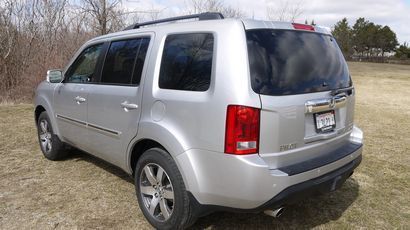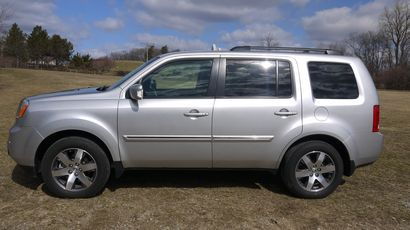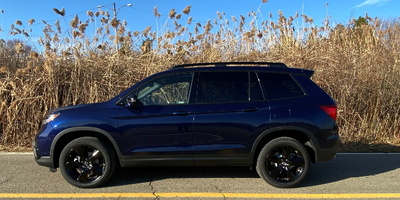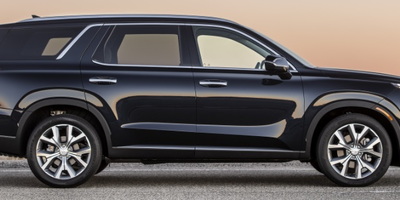A week spent in the versatile midsize SUV from Honda
Pros:
Smooth engine and transmission
Controlled ride
Cargo room, storage, switchgear
Cons:
Generic exterior styling
Interior finish below Honda standards
Electric steering not as satisfying as conventional setup
Some history
The Honda Pilot mid-size crossover SUV was first introduced in the summer of 2002 as a 2003 model. At the time it was, and it continues to remain, Honda's largest SUV.
That iteration was given a facelift in 2006 while the second generation was released in the fourth quarter of 2008 as a 2009 model. The second-gen version received a minor update for the 2012 model year, which should bring us pretty much up to date.
The Pilot shares its platform with the Honda Odyssey as well as with its upmarket stable mate, the Acura MDX.
Unlike the Odyssey, the Pilot is available in either front or all-wheel drive powertrains. Like its minivan cousin, the Pilot is available with just one engine and transmission combination: an all-aluminum V6 featuring a two-stage magnesium intake that produces 250 horsepower at 5,700 rpm and 253 lb.-ft. of torque at 4,800 rpm.
This engine is mated to an automatic transmission with a less than cutting-edge five forward speeds that, together, deliver EPA mileage ratings of 18/25/21 city/highway/combined mpg in front-wheel-drive equipped models and 17/24/20 city/highway/combined mpg in models equipped with four-wheel-drive.
But the drivetrain technology is not all retro. The engine is also equipped with Honda's Variable Cylinder Management system, which electronically deactivates cylinders to reduce fuel consumption. This allows the V6 to run on 3, 4 or 6 cylinders based on power requirements.
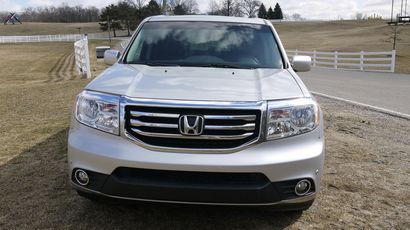
Models equipped with four-wheel-drive also feature Honda's Variable Torque Management System. This means that in extreme low-traction situations – such as being stopped in mud, ice or loose gravel, drivers can manually lock the rear differential to help get things going and keep it manually locked up to 18 miles per hour.
According to manufacturer's data, a 2013 Honda Pilot 4WD Touring weighs 4608 lbs., has a wheelbase of 109.2 inches and is 191.4 inches long. It's also 72.4 inches high, 78.5 inches wide and has front and rear tracks of 67.7 and 67.5 inches, respectively. The 2013 model also has a coefficient of drag of 0.35 – not bad considering its brick-like looks.
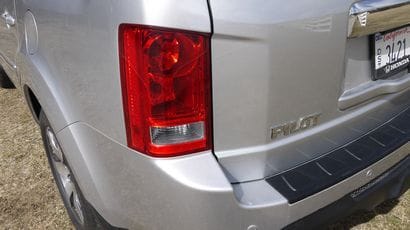
Exterior
This brings us to the exterior and I am reminded of what a big deal was made of the Pilot's new front fascia back in 2011 when the refresh was announced. The SUV's new three-bar grill was probably an attempt to "de-boxify", as it were, Honda's ultimate box. At the same time the black trim surrounding the lower air intake on the front fascia was stretched to include the front fog lamp enclosures – a nice, if subdued, touch.
The new grille, however, replaced the previous model's more unique six-sided insert design. In my humble opinion this makes the Pilot look even a bit more generic. Don't get me wrong, I'm in no way intimating that the Pilot's styling is in any way offensive. In fact, the results are quite the contrary.
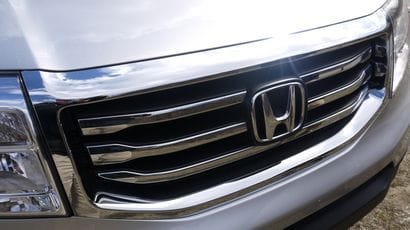
But the fact is that with its new visage the more generic-looking Pilot is now even more difficult to spot in a parking lot full of family haulers. That and the fact that the competition is finding ways to make these big boxes more stylish means that the competition in the segment will only get tougher for Honda.
This is a shame because, overall, the Pilot gives buyers a lot of bang for the buck despite a few more shortcomings – which brings us to the interior.

Interior
Aesthetics aside, what every SUV owner really looks for is versatility For the most part Honda's Pilot is certainly one of the better vehicles in this segment – fitting five adults in comfort and three more in a pinch.
Up front both the pilot and co-pilot will find plenty of head, leg and hip room. The leather-wrapped steering wheel contains backlit controls for cruise, info and entertainment as well as Bluetooth systems and both tilts and telescopes with plenty of adjustment. There's also a proper dead pedal to the left of the brake. The seats are firm and comfortable while the center console arm rest is at just the right height for most drivers.
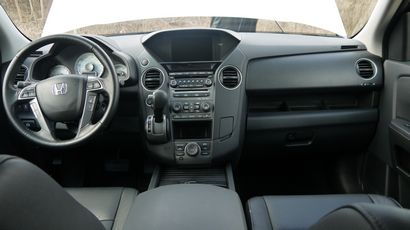
With its large glass area, driver visibility is excellent in the front, sides and in back with a particularly nice feature being a standard backup camera.
Instruments are clear and easy to read, with most of the console and center-stack buttons and controls being very intuitive. One issue I had with had dealt with the fact that many of these buttons were similar-looking and often required a second look in order to hit the right one.
A second issue I had with the Pilot concerned the very un-Honda-like design and finish of the dashboard. The dashboard consists of a number of individual pieces that consist of, for the most part, a lot of hard, dull-finished plastics.

Honda needs to address this issue in the next go-around, as manufacturers such as Ford and Hyundai have both passed Honda in both the materials as well as the fit and finish department.
Getting back to the interior in general, the Pilot features plenty of room in the reclining middle seats for three adults. Third row occupants, on the other hand, should be limited to three kids, although the second-row seats can be moved forward a bit so three adults can squeeze in. Aiding this is the fact that the middle seats flip and slide forward for easy ingress and egress to the third row.
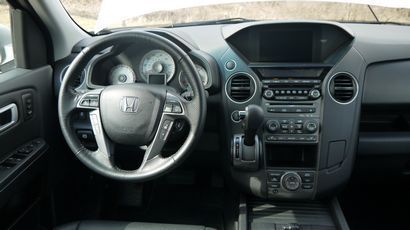
Versatility has also not been forgotten as both the middle as well as the back row features a 60/40 split. There's also plenty of storage in the various bins and cubbies with a nice touch being the storage cover over the lower center console that locks in two position.
Cargo volume behind the third seat is 18.0 cubic feet. If that's not sufficient, stow both halves of the rear seat and it jumps to 47.7 cubic feet. If that's still not enough, simply flip the middle seats forward and, presto, you now have 87.0 cubic feet of cargo room.
Another nice touch is the fact that the powered rear liftgate features a rear window that can be opened separately.
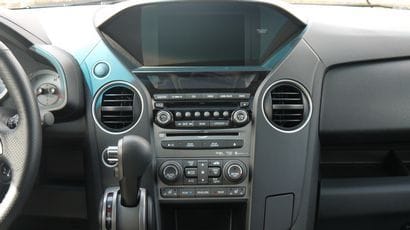
Equipment
The 2013 Pilot comes in a very un-Honda-like twelve different trim configurations.
The "base" LX, available in either front or four-wheel drive, comes standard with six airbags, power windows, locks and mirrors with a power folding feature. Privacy glass is also standard as is automatic climate control, 8-inch i-MID color screen, Bluetooth with Honda's HandsFreeLink voice recognition, a 229-watt AM/FM/CD audio system with subwoofer and 2 GB of storage. A built-in Class III trailer hitch is also standard as is ABS, stability and traction control, hill start assist and active noise cancellation.
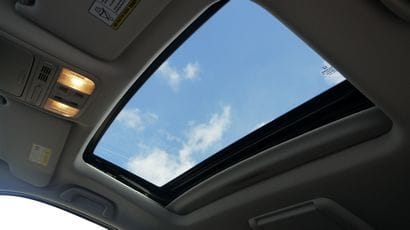
An EX with either front or all-wheel-drive adds, among other things, 18-inch alloy wheels, a security system, fog lights, automatic headlights, bodycolored side mirrors and a 10-way power driver's seat with power lumbar.
All EX-L's, whether FWD or 4WD, add leather, power tailgate with lift-up glass hatch, moonroof, heated front seats, a 4-way power passenger front seat and XM satellite radio.
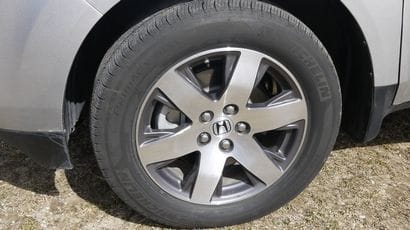
Two additional variations of the EX-L, both with either front or four-wheel-drive add either a DVD rear entertainment system or satellite-linked navigation with 15 gigs of memory storage, multi-angle rearview camera with guidelines and compass and illuminated controls on the steering wheel.
Finally, either front or four-wheel drive Touring models get a trailer harness, both the satellite nav system and the DVD rear entertainment system, integrated turn signals in the outside mirrors, two-position memory for the driver's seat and a 650-watt audio system with 10 speakers, including a subwoofer.
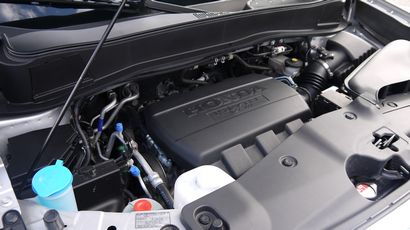
On the road
SUVs and three-row SUVs in particular are, by their very nature, vehicles rarely associated with either twisty roads or straight-line performance. But the fact of the matter is that the Pilot does a nice job of it for a 4,600 pound vehicle.
The ride is both firm and compliant with the suspension doing a nice job of damping out most road imperfections. Although road and tire noise is noticeable especially on rough surfaces, both engine and wind noise is well muted.
The steering is nicely weighted and lacks the numbness of many electric systems, the transmission shifts smoothly, while the brake pedal is easy to modulate and provides good feedback.
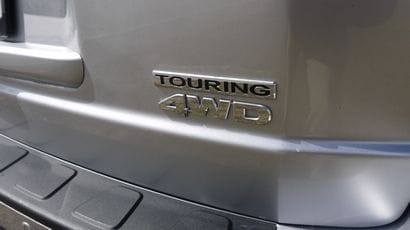
Pricing
Manufacturer suggested new car pricing, including an $810 destination charge, begins at $30,350 for a front-wheel-drive LX and tops out at $42,100 for the Touring model – a figure that matched the price of our Alabaster Silver metallic tester.
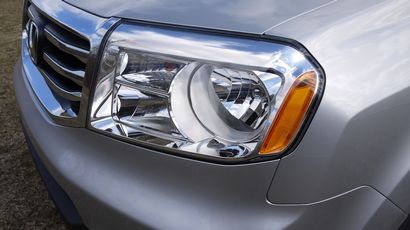
The Bottom Line
So what's the bottom line to all this?
With the Pilot, Honda went the conservative route both inside and out and since its mild redesign in 2009 its biggest SUV has seen only minor changes.
Unfortunately for Honda, in today's market there is a limit on how far the Pilot can go solely on its reputation for quality and durability. The fact is there are a number of SUVs out there that have overtaken it in style as well as fit and finish and the quality of interior materials.
The Pilot brings a lot to the table and it's certainly a decent choice if you're considering a three-row SUV. But unlike a number of other Hondas that I've driven, I wouldn't necessarily insist that you put it at the very top of your shopping list.



